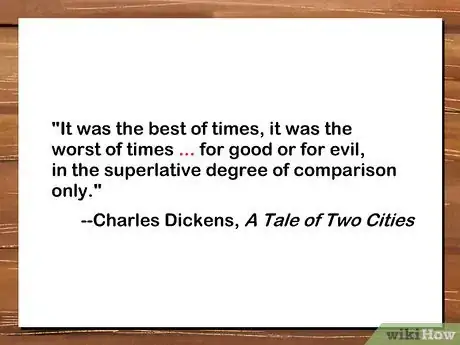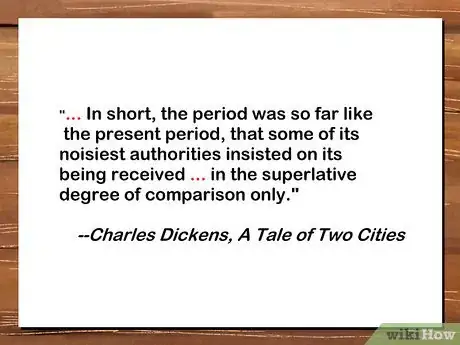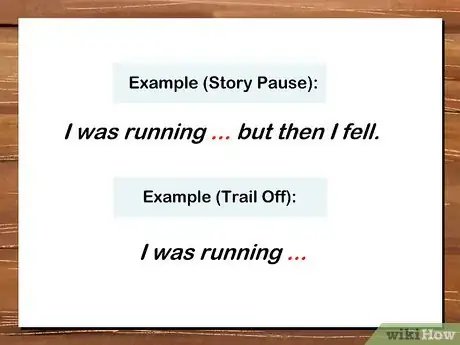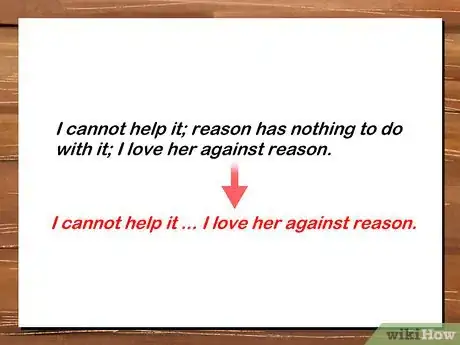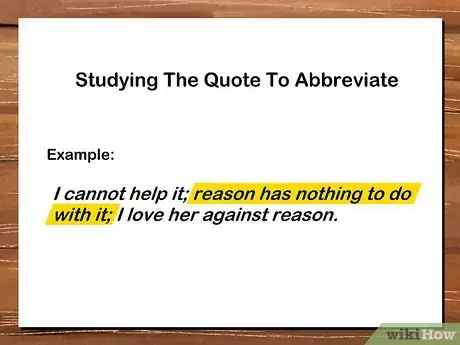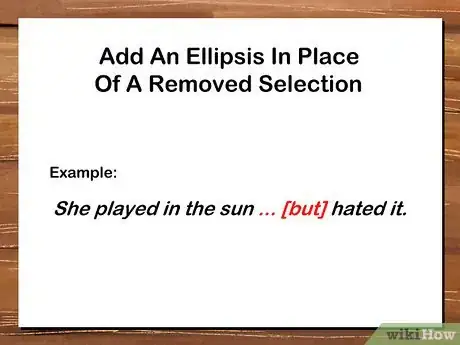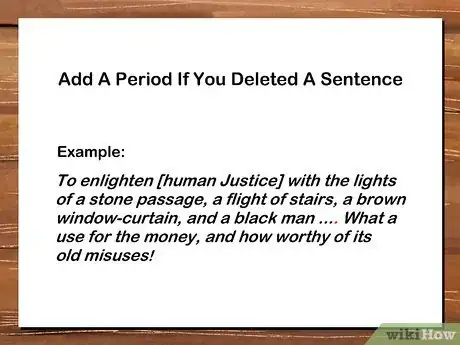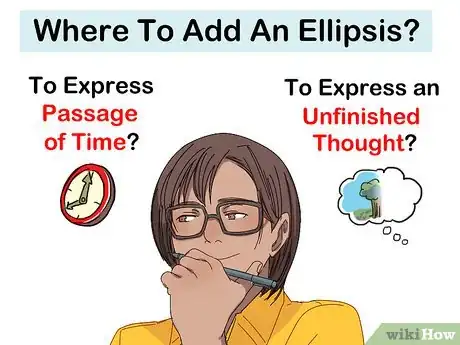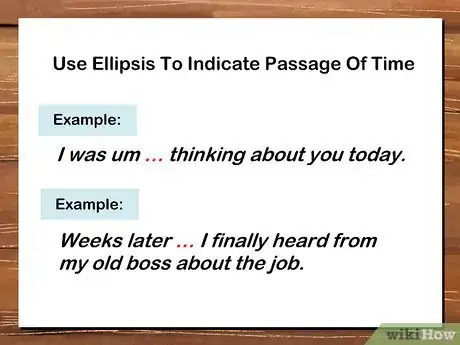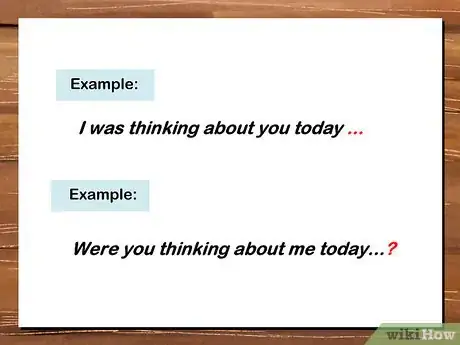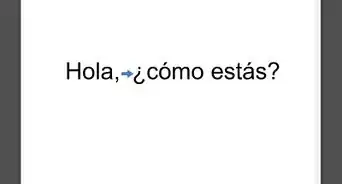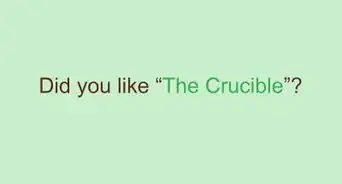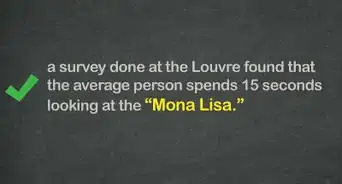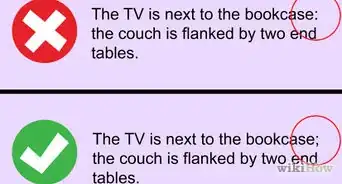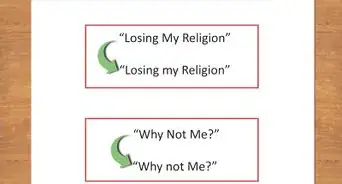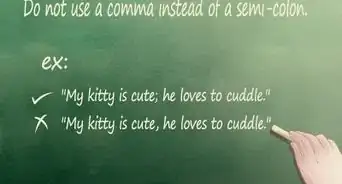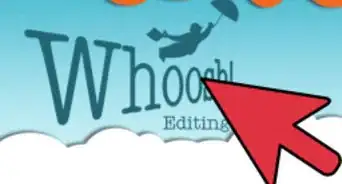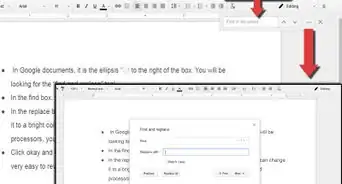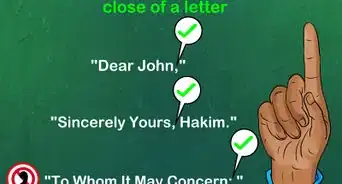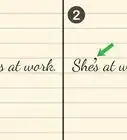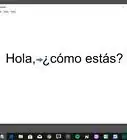This article was co-authored by Michelle Golden, PhD. Michelle Golden is an English teacher in Athens, Georgia. She received her MA in Language Arts Teacher Education in 2008 and received her PhD in English from Georgia State University in 2015.
This article has been viewed 108,018 times.
Sometimes you just need to take a moment to pause and reflect, even in writing. An ellipsis (...) is a piece of punctuation that can be used to indicate a pause or a gap in a piece of text. An ellipsis (plural: ellipses) is employed in both formal and creative writing to signal to the reader that something is missing. Follow these steps for correctly and effectively adding an ellipsis to your writing, whether it's for publication or for fun.
Steps
Deciding to Use an Ellipsis
-
1Determine why you need an ellipsis. There are two main ways an ellipsis is used. One way is to indicate that a quote has been abbreviated. The other is to indicate a pause or trailing off, generally in speech.
- You must be very careful not to influence the meaning of a quote when you replace text with an ellipsis. Only use an ellipsis to shorten a quote if a section is redundant or does not change the meaning.
- Only use an ellipsis to indicate a pause or trailing off in creative or casual writing. An ellipsis used in this way in formal writing, such as for a student essay, would be seen as lazy or even perfunctory.
-
2Reduce length of block quotes. One reason to use an ellipsis to shorten a quote is because the quote is so long that it needs to be offset by increased margins, or “blocked.” It is desirable to eliminate the use of block quotes unless every word is necessary for the purpose of the paper.
- For MLA formatting, block a quote if it is more than four lines of prose or three lines of poetry.[1]
- For APA formatting, block a quote if it is 40 words or longer.[2]
- For Chicago style formatting, block a quote if it is 100 words or longer.[3]
- For example, here is a quote that is long enough to be blocked, but an ellipsis is inserted to make it fit in an essay without having to offset it as a block quote:
- Original: "It was the best of times, it was the worst of times, it was the age of wisdom, it was the age of foolishness, it was the epoch of belief, it was the epoch of incredulity, it was the season of Light, it was the season of Darkness, it was the spring of hope, it was the winter of despair, we had everything before us, we had nothing before us, we were all going direct to Heaven, we were all going direct the other way- in short, the period was so far like the present period, that some of its noisiest authorities insisted on its being received, for good or for evil, in the superlative degree of comparison only." --Charles Dickens, A Tale of Two Cities
- With ellipsis: "It was the best of times, it was the worst of times ... for good or for evil, in the superlative degree of comparison only." --Charles Dickens, A Tale of Two Cities
Advertisement -
3Get to the point. Another reason a writer would abbreviate a quote is to eliminate irrelevant information. A quote may not be long enough to block, but if it contains information that will distract the reader, a writer may choose to exclude it.
- If you are a journalist with a low word limit, it's useful to remove sections of quotes that don't greatly add to the meaning.
- If you want to omit the first part of a sentence because it does not add to the meaning of the quote, begin the quote with an ellipsis, following the capitalization of the sentence.
- For example, we can abbreviate the last phrase of the Dickens quote used above even more using both an opening and interior ellipsis: "... in short, the period was so far like the present period, that some of its noisiest authorities insisted on its being received ... in the superlative degree of comparison only." --Charles Dickens, A Tale of Two Cities
- However, the opening ellipses is not necessary if you are using MLA format.[4]
-
4Make a pause or trail off. If you're writing an informal work, such as with creative writing, it is permissible to use ellipses to show that a character is thinking, hesitant, afraid, and so on. An ellipsis also creates an element of suspense when a character trails off because it presents an unresolved idea.
- You can use an ellipsis in personal writing as well, such as in informal emails or diary entries. In this case, the ellipsis would indicate your thoughts have trailed off.
- You also use the ellipsis technique to indicate that a character's thoughts have trailed off, not just their dialogue.
- For example, if you wanted to have a character in a story pause, they might say, "I was running ... but then I fell."
- To show a character trailing off, they might simply say, "I was running ..."
Abbreviating a Quote
-
1Choose a section of the quote. Although choosing which section of a quote to abbreviate for a student paper or published article is up to editorial discretion (ie, it's up to you), you must be careful not to influence the meaning of the quote in any way.
- To make sure you aren't changing the meaning, choose words that are not essential to understanding a quotation.
- Leave verbs and new subjects alone, but take out words that are already understood by the reader. In other words, it's permissible to remove phrases that are redundant or repetitive.
- For example, here is another Charles Dickens quote, this time from the novel Our Mutual Friend: "I cannot help it; reason has nothing to do with it; I love her against reason."
- Here is the quote with a redundant phrase removed: "I cannot help it ... I love her against reason."
-
2Study the quote. Write out the full quote and study it to determine which parts may not be necessary. Then use a highlighting tool to select these words and phrases. Read the quote aloud, omitting these highlighted words.
- If you can tell that you have changed the meaning, work with the highlighted areas until you have preserved the original meaning of the quote.
- For example, if you were working with the above quote, the bolded words are marked for removal: "I cannot help it; reason has nothing to do with it; I love her against reason."
-
3Create the ellipsis. Once you have studied the quote and selected passages to omit, go ahead and delete or erase them. In place of the removed section(s), write an ellipsis.
- If the removed section leaves the quote grammatically incorrect, add a word or short phrase that bridges the gaps in square brackets [ ] after the ellipsis.
- For example, it would look like: "She played in the sun ... [but] hated it."
-
4Add a period when you delete a sentence. If you have determined it is possible to delete the rest of a sentence or a whole sentence, you need to add the period that would have been there after the ellipsis. The ellipsis would then look like it has four dots.
- Remember that an ellipsis has only three dots. The fourth dot is always a period.
- Begin the next part of the quotation with a capital letter if it is the beginning of a new sentence.
- For example, if you were quoting from the same passage as the Dickens quote in this method, you would take out the sentences we used above and leave the sentences around it like this:
- "To enlighten [human Justice] with the lights of a stone passage, a flight of stairs, a brown window-curtain, and a black man .... What a use for the money, and how worthy of its old misuses!"
Indicating a Pause
-
1Choose where to add an ellipsis. To determine where you want to add an ellipsis in creative or informal writing, you should ask yourself a question: Do you want to add an ellipsis to express passage of time, or do you want it to express an unfinished thought?
-
2Indicate passage of time. One way to use an ellipsis to indicate a pause is when you want to describe passage of time without words. This ellipsis most often occurs in the middle of a sentence.
- Insert the ellipsis between two words where the pause occurs.
- The passage of time can be very short, almost instantly, such as with this sentence: “I was um … thinking about you today.”
- The passage of time can be much longer, days or weeks, such as with this sentence: “Weeks later … I finally heard from my old boss about the job.”
- An ellipsis used to express passage of time can often be substituted for the phrase “and then.”
-
3Indicate an unfinished thought. When a piece of dialogue or a thought is said to “trail off,” this means it is an unfinished thought. You should use an ellipsis to express an unfinished thought at the end of the sentence.
- Insert the ellipsis after the last word to trail off at the end of a sentence.
- “I was thinking about you today ...”
- If the ellipsis occurs at the end of the sentence and the sentence would normally end with a question mark or exclamation point, place it after the ellipsis.
- “Were you thinking about me today...?”
- Insert the ellipsis after the last word to trail off at the end of a sentence.
Community Q&A
-
QuestionHow would I use an ellipsis in this quote: "A river watering the garden flowed from Eden;"? There's a second half to this quote, but I just want the first half. Notice the semi-colon after Eden as well.
 Community AnswerAn ellipsis in this situation indicates omitted content, and it doesn't discriminate. You can safely remove the semicolon: "A river watering the garden flowed from Eden..." Though you could also keep it if you wanted: "A river watering the garden flowed from Eden;..." However, most readers will find the second option strange, ugly, and unpleasant. You're safer with the first example.
Community AnswerAn ellipsis in this situation indicates omitted content, and it doesn't discriminate. You can safely remove the semicolon: "A river watering the garden flowed from Eden..." Though you could also keep it if you wanted: "A river watering the garden flowed from Eden;..." However, most readers will find the second option strange, ugly, and unpleasant. You're safer with the first example. -
QuestionShould I put a space before the question mark if it follows the ellipsis?
 DonaganTop AnswererNo, a space is not necessary.
DonaganTop AnswererNo, a space is not necessary. -
QuestionIf it's just trailing off in the middle of a paragraph, do I use a full stop after the ellipsis?
 DonaganTop AnswererYou don't need a full stop. The ellipsis can serve to end the sentence, or it can indicate a pause in the middle of a sentence.
DonaganTop AnswererYou don't need a full stop. The ellipsis can serve to end the sentence, or it can indicate a pause in the middle of a sentence.
References
About This Article
When you’re writing, you can use an ellipsis to indicate a pause in speech, or you can use it to shorten a quote. In formal writing, if you’ve chosen to include parts of a quote, use an ellipsis in place of any sections of the quote that are unnecessary to the point you’re trying to make. However, never use ellipses to change the meaning of the quote you’re using. Also, keep in mind that an ellipsis that indicates a pause should only be used in casual or creative writing. For tips from our Writing co-author on how to punctuate a sentence that includes an ellipsis, keep reading!

